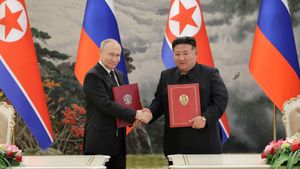Understanding the Middle Corridor is becoming increasingly significant as the Central Asian trade routes come to the fore, especially with developments linking various countries and promoting sustainable economic growth across the region. One of the most notable infrastructure advancements has been the Trans-Caspian International Transport Route (TITR), which has emerged as a key alternative for trade shifting away from routes through Russia. The importance of these trade routes cannot be overstated, particularly amid the current geopolitical climate, which has prompted many businesses to seek new channels for the transport of goods.
On October 21, 2023, Bahnoperator Austria and KTZ Express, part of Kazakhstan Railways, solidified their partnership by signing a memorandum aimed at facilitating regular cargo shipments via the Middle Corridor. This memorandum is part of the growing recognition of the TITR, which plays a pivotal role by linking China with Europe through Central Asia. Goods originating from China are traversing through Kazakhstan, crossing the Caspian Sea, proceeding through Azerbaijan and Georgia, and branching out to Turkiye or traveling across the Black Sea to destinations like Bulgaria, Romania, or Ukraine. Notably, Russia is absent from this arrangement, showcasing the TITR's potential to bypass traditional Northern Corridor routes.
Rovshan Rustamov, the Chairman of Azerbaijan Railways, highlighted the burgeoning interest from global logistics markets, stating, "The Middle Corridor is witnessing significant changes as companies seek alternatives to Russia, largely due to sanctions resulting from the Ukraine War. This shift has resulted in freight volumes on the TITR surging by 70 percent from January to September 2024 compared to the same period last year.” This spike signals not just the viability but also the necessity of developing and promoting alternate trade routes.
Adjacent countries have also recognized the strategic advantages of engaging with the Middle Corridor. Turkmenistan, along with the European Union, initiated a Coordination Platform aimed at enhancing Central Asian collaboration on the TITR to support infrastructure projects pivotal for the corridor's success. A significant challenge the TITR has faced involves congestion points—particularly in Kazakhstan—that have led to increased border wait times, prompting companies to explore alternative transit routes.
Countries like Kazakhstan stand to gain immensely from any efforts to streamline logistics and improve infrastructure. During the same January to September window, the volume of transportation between Russia and China through Kazakhstan rose by 63 percent compared to the previous year. KTZ Express is also engaging with Russian and Chinese partners to establish the CRK Terminal, which will function as a central transport and logistics hub, enhancing the connectivity of this budding trade network.
Interestingly, Kazakhstan is adeptly maneuvering between the interests of Western allies and Russian/Chinese investments to fulfill its national ambitions. The recent emphasis by Kazakh President Kassym-Jomart Tokayev on strengthening ties with Germany could serve to integrate the TITR with the Trans-European Transport Network (TEN-T) and the Global Gateway initiative, which serves as Western counterpart to China’s Belt and Road Initiative (BRI).
To some, leveraging connections with China for Western benefit might become controversial. Yet, recognizing China's enthusiasm for the Middle Corridor as it seeks to facilitate trade with Europe may be advantageous. Kazakhstan, having already embarked on 52 collaborative projects with the Chinese worth over $21.2 billion, displays the potential for dual engagement. This isn't simply about siding with one global powerhouse over another; it's about leveraging relationships to benefit its economy.
Consequently, the West should intensify its support for the Middle Corridor, establishing it as a key player even as China grows increasingly involved. This is not creating a new dependency; rather, it's optimizing the flow of goods from Beijing to Europe without reliance on Russian routes. By investing and aiding Central Asia's infrastructure, the West can not only secure reliable trading partners but also gain increased oversight of the goods moving along these Eurasian pathways.
Support from American development agencies can complement existing European partnerships aimed at maximizing the effectiveness of the TITR. With proper engagement, the West can assert itself as a competitive alternative to competing Russian and Chinese interests. The dynamics surrounding the Middle Corridor encapsulate not just regional trade aspirations but also strategic geopolitical maneuvers.
Shifting focus from the Middle Corridor to the Pan-Asian Railway Network (PARN), another ambitious proposal aims to interconnect eight countries from China down to Singapore, providing even more avenues for trade and movement. This initiative under China’s Belt and Road Initiative promises to promote efficiency through seamless transportation of passengers and cargo.
The PARN will serve to expedite travel and facilitate tourism alongside international trade, as described by Datuk Seri Tan Thian Lai, president of the One Belt One Road Chamber of Commerce, who noted its dual role as both a facilitator for business and tourism. Significant investments like the East Coast Rail Link (ECRL) already under construction promise to shorten travel times and improve the overall connectivity of the ASEAN region.
The ECRL project, expected to be completed by the end of 2026, is projected to cut travel time significantly between various key locations, positioning Malaysia as a central hub within the PARN. Not only will this contribute to domestic growth, but it also establishes ASEAN as pivotal among global trade routes.
Prof Dr. Azmi Hassan, senior fellow with the Nusantara Academy for Strategic Research, echoed this sentiment, asserting the rail project’s potential as “one of the main initiatives” capable of propelling the region to economic prominence. The range of connections within ASEAN plays to the advantage of all member states, allowing for equitable growth opportunities.
For residents of ASEAN nations, the PARN is set to not just enable travel to visit friends across borders—much like the author’s friendship with a Laotian counterpart—but can fundamentally bolster regional cooperation and enrich local cultures through increased interactions.
The past few years have highlighted the resilience and adaptability of trade routes through Central Asia and Southeast Asia, which have the potential to redefine how goods move globally. The myriad of partnerships developing through corridors like the TITR and PARN can help sustain economic growth and broaden horizons for many nations involved, marking the return of historic trade networks to their former glory.
Understanding how these corridors evolve is key. Countries strategically investing in their infrastructure, from Kazakhstan to those along the Pan-Asian Railway, appear poised for growing roles on the world stage. The time has come for both West and East to acknowledge the significance of these trade routes—not merely as channels for goods, but as symbols of connectivity and cooperation among nations.



